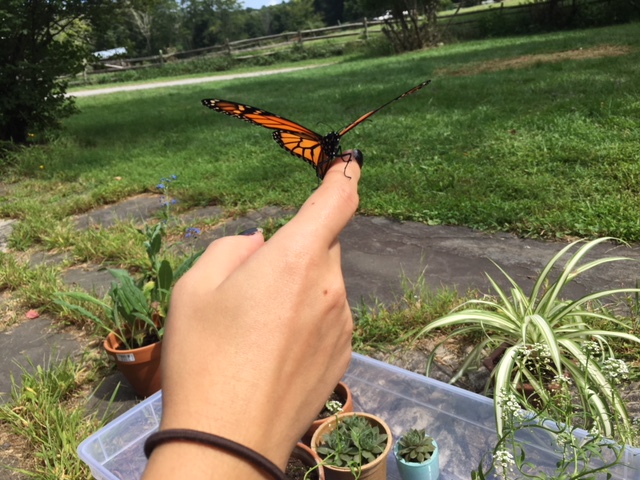From late-August and several weeks into fall I saw monarchs flutter by, enjoying the late summer sun and blooms. Every time I saw one pass, I stopped and wondered if it was one of the caterpillars I spent so many hours looking after.
A few weeks into my caterpillar-rearing experience and my three monarch babies that had started out so small were growing rapidly. No longer tiny wigglers, they now munched through milkweed so loudly that when I sat quietly with them, I could actually hear them chomping away. I knew that at this point it was only a matter of days before they would molt one final time and begin metamorphosis.
I learned while raising caterpillars that they molt their skin five times before metamorphosing and becoming adults (have you checked out my first two blogs, here and here?). The final time they molt will be when they pupate, or begin their transformation into butterfly-hood. To begin the next stage of their life, the caterpillar will first find a suitable place to call home for the next 10 days or so, usually away from milkweed to avoid being accidentally chomped on (if your caterpillars are in an open container like mine were, it’s at this point that you want to find some sort of ventilated lid or net to enclose them or they’ll crawl far away in search of new spot). It will then spin a relatively large and secure web of silk to hang from so that the body drops straight down and the head curls up slightly, forming a “J”. After J-ing for some hours the caterpillar will detach itself from its skin on the inside, which will then split open by the back of the head. With a bit of squirming and maneuvering the old skin will be forced off the body and underneath the pupa is revealed. Soft at first, the pupa hardens up and smooths out over time and becomes the iconic jade-green chrysalis monarchs are known for.
These last moments as a caterpillar are truly incredible, especially if you’re lucky enough to catch the change in action. When my oldest caterpillar pupated, I think I missed the actual molting by only a few minutes. When I went to bed it was still J-ing, and when I woke up it was green and wiggly and had just pushed its skin off. Even though I had missed most of the molting process, I was still ridiculously excited. This little guy was one major step closer to being a butterfly.
I was much luckier with my younger two larvae- I happened to be around to see them shed their skin and reveal their pupae. The whole shedding business takes only a minute or two, but I gawked the entire time. The processes was fascinatingly alien; to see their skin split open while a chubby green blob worms its way out was so strange and amazing.
What’s more amazing is what happens to the monarch inside the chrysalis. New parts of the butterfly, like the wings, are already visible through the thin outer layer of the chrysalis several days before the butterfly emerges. This time of complete change has inspired humans for as long as we have been able to witness it, and one artist in particular makes gorgeous necklaces out of glass that depict the initial and final stages of a monarch’s life in the chrysalis. You can check out her work here.
When the pupa darkens and the famous orange wings of the monarch become visible it means the butterfly has grown too big and must move on. Unfortunately, I missed the emergence- three times I came home from work and saw a fully grown monarch sunning its wings, waiting for me to set it free. Saying goodbye to my butterflies was bittersweet- I was sad to see them going after caring for them for the past month, but I knew they needed to be out in the world, pollinating plants and eventually journeying to Mexico.
From late-August and several weeks into fall I saw monarchs flutter by, enjoying the late summer sun and blooms. Every time I saw one pass, I stopped and wondered if it was one of the caterpillars I spent so many hours looking after. Raising monarchs was stressful at points, but it was also rewarding to send off beautiful butterflies after seeing them start life so small and vulnerable. After spending so much time bonding with these critters, I’ve decided I’d like to raise a few next summer, if I can find them. If you’d like to see monarchs in your garden or woodlot and you’ve got the time and the milkweed, then I encourage you to try it, too!










